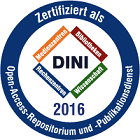Schwarz, Nadine: Investigation of the Endothelial Protein C Pathway Response and its Influence on the Thrombotic Risk in Carriers of the Factor V Leiden Mutation. - Bonn, 2024. - Dissertation, Rheinische Friedrich-Wilhelms-Universität Bonn.
Online-Ausgabe in bonndoc: https://nbn-resolving.org/urn:nbn:de:hbz:5-79402
Online-Ausgabe in bonndoc: https://nbn-resolving.org/urn:nbn:de:hbz:5-79402
@phdthesis{handle:20.500.11811/12480,
urn: https://nbn-resolving.org/urn:nbn:de:hbz:5-79402,
doi: https://doi.org/10.48565/bonndoc-412,
author = {{Nadine Schwarz}},
title = {Investigation of the Endothelial Protein C Pathway Response and its Influence on the Thrombotic Risk in Carriers of the Factor V Leiden Mutation},
school = {Rheinische Friedrich-Wilhelms-Universität Bonn},
year = 2024,
month = oct,
note = {Venous thrombosis and its potentially life-threatening complication pulmonary embolism are caused by the formation of an intravascular blood clot. Though there is a myriad of potential etiologies for this condition, the factor V Leiden mutation (FVL) is its most common genetic risk factor in populations of Caucasian descent. FVL affects the anticoagulant protein C (PC) system, in which PC is activated as a result of coagulation activation in an interplay between factors in the circulation and endothelial receptors.
However, under comparable environmental conditions, the clinical expressivity of the thrombotic phenotype is highly variable between FVL carriers. Recently, in vivo human studies showed that the formation of activated PC (APC) in response to coagulation activation induced by recombinant activated factor VII is increased in FVL carriers without a history of thrombosis (asymptomatic) compared to FVL carriers with a history of thrombosis (symptomatic). Starting from this observation, this thesis focuses on the question of which factors modulate the thrombotic risk in FVL carriers via either direct or indirect interaction with the mutation. Following the hypothesis that differences in the PC system may contribute to this phenomenon, symptomatic and asymptomatic FVL carriers were examined for differences in pathways affecting the PC system, in terms of 1.) thrombin formation, 2.) APC formation, and 3.) fibrinolysis.
Experimental strategies included the measurement of in vitro and in vivo thrombin generation in FVL carriers and other thrombophilia patients, as described in chapter 2.1. Alterations in the fibrinolytic system following recombinant FVIIa-induced coagulation activation in symptomatic and asymptomatic FVL carriers were addressed in chapter 2.2 using the same in vivo model. Furthermore, in order to study APC formation in detail, an ex vivo model of the PC pathway using patient-derived endothelial cells and autologous plasma was established (chapter 2.3) and applied to symptomatic and asymptomatic FVL carriers (chapter 2.4).
While analyses of in vitro thrombin generation and potential influencing factors did not show differences between FVL carriers with and without a history of thrombosis, or between FVL carriers and FVL non carriers, changes in the fibrinolytic system after in vivo stimulation of thrombin and APC formation showed specific differences between symptomatic and asymptomatic FVL carriers. The ex vivo model of the PC system revealed that the APC response to thrombin formation was significantly more pronounced in asymptomatic than symptomatic FVL carriers, although no differences in the expression of the PC system relevant membrane proteins thrombomodulin and endothelial PC receptor, or APC inactivation kinetics were observed. In subsequent crossover experiments, endothelial cells were identified as the causative factor of a more pronounced APC response in asymptomatic FVL carriers.
Taken together, these results affirm the hypothesis that components of the PC system modulate the thrombotic risk in FVL carriers and indicate the involvement of endothelial features. Further studies are warranted to study the endothelial influence on APC formation in FVL in more detail. A more general achievement of the presented research is the successful establishment of a personalized ex vivo model that can be applied to study the functionality of the anticoagulant PC system in individual patients, including potentially in clinical diagnostics in the future.},
url = {https://hdl.handle.net/20.500.11811/12480}
}
urn: https://nbn-resolving.org/urn:nbn:de:hbz:5-79402,
doi: https://doi.org/10.48565/bonndoc-412,
author = {{Nadine Schwarz}},
title = {Investigation of the Endothelial Protein C Pathway Response and its Influence on the Thrombotic Risk in Carriers of the Factor V Leiden Mutation},
school = {Rheinische Friedrich-Wilhelms-Universität Bonn},
year = 2024,
month = oct,
note = {Venous thrombosis and its potentially life-threatening complication pulmonary embolism are caused by the formation of an intravascular blood clot. Though there is a myriad of potential etiologies for this condition, the factor V Leiden mutation (FVL) is its most common genetic risk factor in populations of Caucasian descent. FVL affects the anticoagulant protein C (PC) system, in which PC is activated as a result of coagulation activation in an interplay between factors in the circulation and endothelial receptors.
However, under comparable environmental conditions, the clinical expressivity of the thrombotic phenotype is highly variable between FVL carriers. Recently, in vivo human studies showed that the formation of activated PC (APC) in response to coagulation activation induced by recombinant activated factor VII is increased in FVL carriers without a history of thrombosis (asymptomatic) compared to FVL carriers with a history of thrombosis (symptomatic). Starting from this observation, this thesis focuses on the question of which factors modulate the thrombotic risk in FVL carriers via either direct or indirect interaction with the mutation. Following the hypothesis that differences in the PC system may contribute to this phenomenon, symptomatic and asymptomatic FVL carriers were examined for differences in pathways affecting the PC system, in terms of 1.) thrombin formation, 2.) APC formation, and 3.) fibrinolysis.
Experimental strategies included the measurement of in vitro and in vivo thrombin generation in FVL carriers and other thrombophilia patients, as described in chapter 2.1. Alterations in the fibrinolytic system following recombinant FVIIa-induced coagulation activation in symptomatic and asymptomatic FVL carriers were addressed in chapter 2.2 using the same in vivo model. Furthermore, in order to study APC formation in detail, an ex vivo model of the PC pathway using patient-derived endothelial cells and autologous plasma was established (chapter 2.3) and applied to symptomatic and asymptomatic FVL carriers (chapter 2.4).
While analyses of in vitro thrombin generation and potential influencing factors did not show differences between FVL carriers with and without a history of thrombosis, or between FVL carriers and FVL non carriers, changes in the fibrinolytic system after in vivo stimulation of thrombin and APC formation showed specific differences between symptomatic and asymptomatic FVL carriers. The ex vivo model of the PC system revealed that the APC response to thrombin formation was significantly more pronounced in asymptomatic than symptomatic FVL carriers, although no differences in the expression of the PC system relevant membrane proteins thrombomodulin and endothelial PC receptor, or APC inactivation kinetics were observed. In subsequent crossover experiments, endothelial cells were identified as the causative factor of a more pronounced APC response in asymptomatic FVL carriers.
Taken together, these results affirm the hypothesis that components of the PC system modulate the thrombotic risk in FVL carriers and indicate the involvement of endothelial features. Further studies are warranted to study the endothelial influence on APC formation in FVL in more detail. A more general achievement of the presented research is the successful establishment of a personalized ex vivo model that can be applied to study the functionality of the anticoagulant PC system in individual patients, including potentially in clinical diagnostics in the future.},
url = {https://hdl.handle.net/20.500.11811/12480}
}






